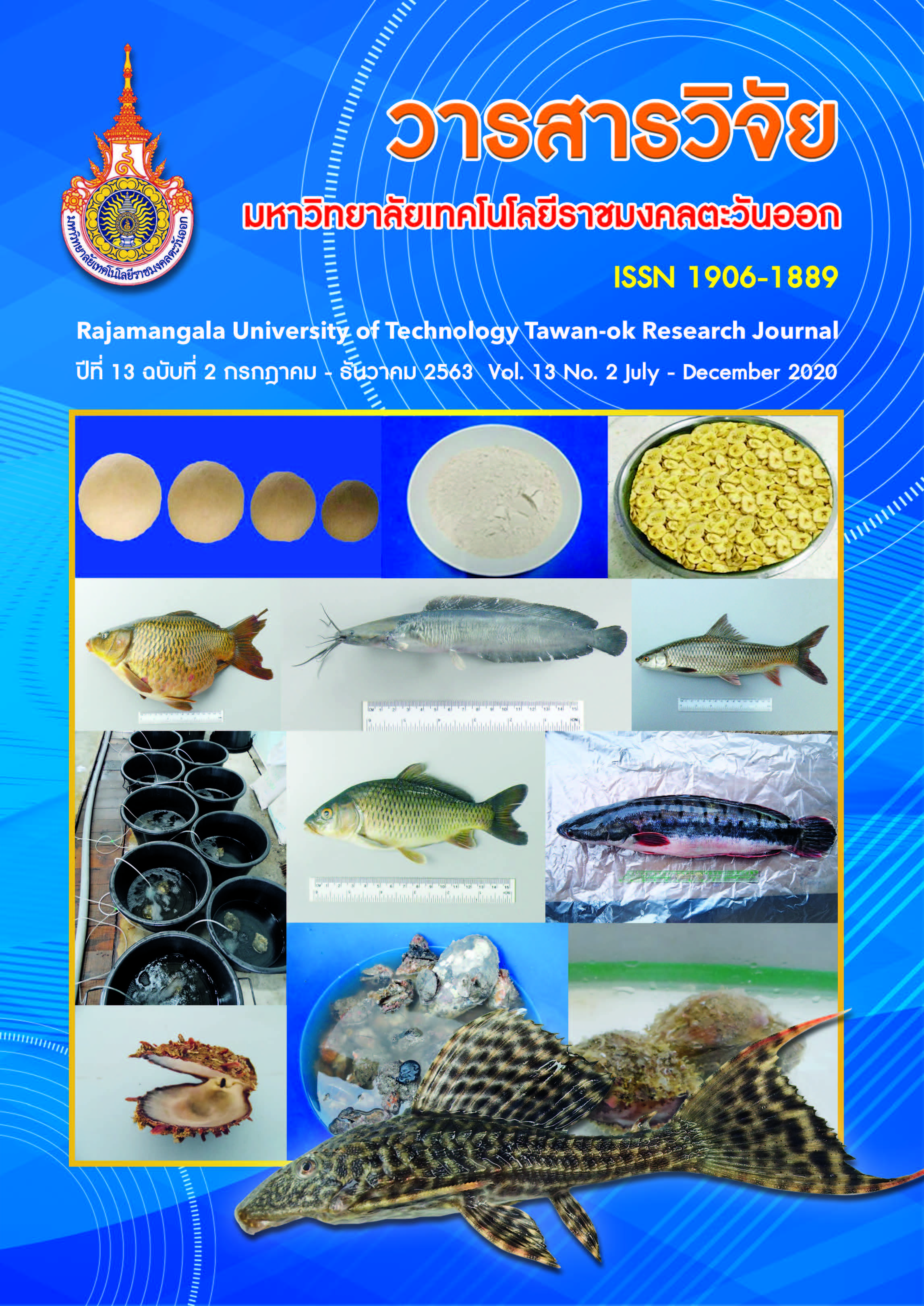ความหลากชนิดและการแพร่กระจายของแมลงน้ำในอ่างเก็บน้ำเขื่อนน้ำอูน จังหวัดสกลนคร
Main Article Content
บทคัดย่อ
การศึกษาครั้งนี้มีวัตถุประสงค์เพื่อศึกษาความหลากชนิดและการแพร่กระจายของแมลงน้ำในอ่างเก็บน้ำเขื่อนน้ำอูน จังหวัดสกลนคร ระหว่างเดือน พฤศจิกายน 2556 ถึง เดือนตุลาคม 2557 พบแมลงน้ำ4 อันดับ 8 วงศ์ ได้แก่ วงศ์ Dytiscidae Baetiscidae Belostomatidae Hydrometridae Nepidae Coenagrionidae Gomphidae และ Libellulidae ความชุกชุมของแมลงน้ำมีค่าเฉลี่ยเท่ากับ 100.94 ± 108.01 ตัวต่อตารางเมตร ความหลากชนิดและ ดัชนีความหลากหลายทางชีวภาพมีค่าเฉลี่ยเท่ากับ 4.27 ± 1.53 และ 0.94 ± 0.25 ตามลำดับ โดยความชุกชุมและ ความหลากชนิดของแมลงน้ำในฤดูกาลที่สำรวจมีความแตกต่างกันอย่างมีนัยสำคัญทางสถิติ (P < 0.05) จากการวิเคราะห์ องค์ประกอบหลัก การกระจายตัวของแมลงน้ำแต่ละพื้นที่และฤดูกาล พบการกระจายตัวของแมลงน้ำเป็น 2 กลุ่มหลัก คือ กลุ่มที่ 1 เป็นแมลงน้ำที่แพร่กระจายช่วงฤดูหนาวในสถานีที่ 1 ได้แก่ ด้วงน้ำ(DYSP) แมลงดาเล็ก (BESP) จิงโจ้น้ำ(GESP) และตัวอ่อนแมลงปอเข็ม (ARSP) โดยมีลักษณะการแพร่กระจายไปในทิศทางเดียวกับความชุกชุม และกลุ่มที่ 2 เป็นแมลงน้ำที่มีการแพร่กระจายในช่วงฤดูร้อนในสถานีที่ 5 ได้แก่ ตัวอ่อนแมลงปอบ้าน (LISP) ตัวอ่อนแมลงปอบ้าน (HASP) มวนน้ำหางยาว (RASP) และตัวอ่อนแมลงชีปะขาว (EPSP) โดยมีลักษณะการแพร่กระจายสัมพันธ์ไปในทิศทาง เดียวกับความหลากชนิด ดัชนีความหลากหลายทางชีวภาพ อุณหภูมิของน้ำและค่าออกซิเจนที่ละลายในน้ำ
Article Details
References
[2]APHA. AWWA. WEF. 1998. Standard Method for the Examination for Water and Watsewater. 20th ed. Washington, DC. American Public Health Association.
[3]Chaisri, K., Kunpradid, T., Peerapornpisal, Y. and Phalaraksh, C. 2009. Distribution of Aquatic Insects in Lao River, Chiang Rai Province. Journal of Fisheries Technology Research. 3(1): 161-172. (in Thai)
[4]Clarke, K.R. and Warwick. R.M. 1994. Change in Marine Communities; an approach to statistical analysis and interpretation. Plymouth, Plymouth Marine Laboratory.
[5]Dudgeon, D. 1999. Tropical Asian stream: Zoobenthods, Ecology and conservation. Hong Kong University Press. Hong Kong.
[6]McCafferty, W.P. and Provonsha, A.V. 1981. Aquatics entomology. Boston. Jones and Bartlett Publishers Inc. Boston.
[7]Meteorological Department. 2020. Climate of Thailand. [online]. http://www.tmd.go.th/info/info.php? FileID=53. Accessed 15 May 2020.
[8]Minewang, N., Phayakkha, A. and Prommi, T. 2012. An application of aquatic insects as bioindicators of water quality in Mae Tao creek, Mae Sot District, Tak Province. SDU Res. J. 5(2): 113-123. (in Thai)
[9]Ngamsnae, P. 2011. Monitoring and bio-indicators for assessment of freshwater ecosystems. Department of Fisheries. Faculty of Agriculture. Ubon Ratchathani University. (in Thai)
[10]Pennak, R. W. 1953. Fresh Water Invertebrate of The United States. Library of Congress Catalog Card Number : 52-12522.
[11]Prommi, T. 2011. Biodiversity and community structure of aquatic insects in permanent freshwater. Veridian E-Journal SU. 4: 917-930. (in Thai)
[12]Rattanaboontha, J. and Sangpradub, N. 2010. Species diversity and distribution of Odonate larvae in Pong River. KKU Res J. (Graduate Studies) 10 (3): 1-6. (in Thai)
[13]R Development Core Team. 2009. R: A language and environment for statistical computing. Vienna, Austria: R Foundation for Statistical Computing.
[14]Richards, C., Host, G.H. and Arthur, A.W. 1993. Identification of Predominant Environmental Factors Structuring Stream Macroinvertebrate Communities Within a Large Agricultural Catchment. Freshwater Biology. 29: 285-294.
[15]Sangpradub, N. 2005. Document for teaching 311780 aquatic insects. Department of Biology, Faculty of Science, Khon Kaen University. (in Thai)
[16]Sangpradub, N., Inmoung, Y. Hanjavanit, C. and Inmoung, U. 1998. A Correlation study between freshwater benthic macroinvertebrate fauna and environmental quality factor in Nam Pong basin Thailand part III. A research report to the Thailand research fund. (in Thai)
[17]Sangpradub, N. and Boonsoong, B. 2006. Identification of Freshwater Invertebrate of the Mekong River and its Tributaries. Mekong River Commission, Vientiane.
[18]Slavevska-Stamenkovic, V., Stafilov, T., Smiljkov, S., Paunovic, M. and Hristovski, S. 2009. Quality of water of Mantovo reservoir (Republic of Macedonia). Arch.Biol. Sci., Belgrade. 61(3): 501-512.
[19]Soontornprasit, K. 2012. Use of Aquatic Insects as Bioindicators of Water quality in Kwan Phayao, Phayao Province. Journal of Community Development Research. 5: 15-24. (in Thai)
[20]Soontornprasit, K. Valunpion, S. and Pithakpol, S. 2013. Biodiversity of aquatic insect in Ing river. Khon Kaen Agr. J. 41 (Suppl1): 142-148. (in Thai)
[21]Thanee, I. 2014. Use of Benthic Macroinvertebrates for Biological Monitoring. SDU Res. J. 7: 125-138. (in Thai)
[22]Yule, C. M. and Sen, Y. M. 2004. Freshwater invertebrates of the Malaysian region. Aura productions Sdn. Bhd. Selangor, Malaysia.

